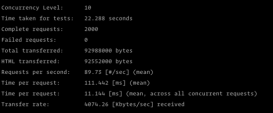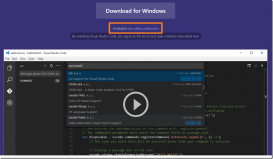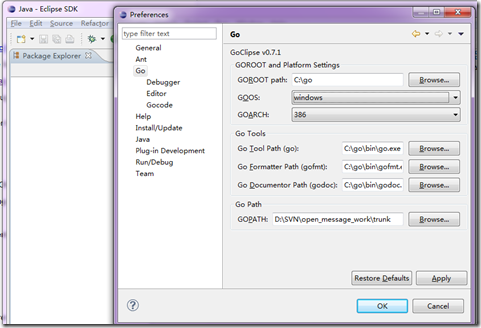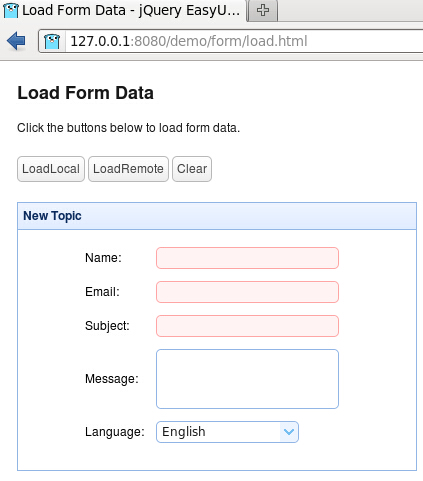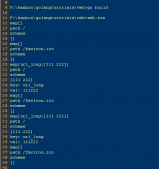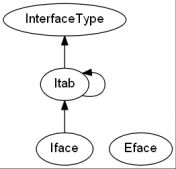Golang的string类型底层数据结构简单,本质也是一个结构体实例,且是const不可变。
string的底层数据结构
通过下面一个例子来看:
|
1
2
3
4
5
6
7
8
9
10
11
12
13
14
15
16
17
18
19
20
21
22
23
24
25
26
|
package mainimport ( "fmt" "unsafe")// from: string.go 在GoLand IDE中双击shift快速找到type stringStruct struct { array unsafe.Pointer // 指向一个 [len]byte 的数组 length int // 长度}func main() { test := "hello" p := (*str)(unsafe.Pointer(&test)) fmt.Println(&p, p) // 0xc420070018 &{0xa3f71 5} c := make([]byte, p.length) for i := 0; i < p.length; i++ { tmp := uintptr(unsafe.Pointer(p.array)) // 指针类型转换通过unsafe包 c[i] = *(*byte)(unsafe.Pointer(tmp + uintptr(i))) // 指针运算只能通过uintptr } fmt.Println(c) // [104 101 108 108 111] fmt.Println(string(c)) // [byte] --> string, "hello" test2 := test + " world" // 字符串是不可变类型,会生成一个新的string实例 p2 := (*str)(unsafe.Pointer(&test2)) fmt.Println(&p2, p2) // 0xc420028030 &{0xc42000a2e5 11} fmt.Println(test2) // hello, world} |
string的拼接与修改
+操作
string类型是一个不可变类型,那么任何对string的修改都会新生成一个string的实例,如果是考虑效率的场景就要好好考虑一下如何修改了。先说一下最长用的+操作,同样上面的例子,看一下+操作拼接字符串的反汇编:
|
1
2
3
4
5
6
7
8
9
10
11
12
13
14
15
16
|
25 test2 := test + " world" 0x00000000004824d7 <+1127>: lea 0x105a2(%rip),%rax # 0x492a80 0x00000000004824de <+1134>: mov %rax,(%rsp) 0x00000000004824e2 <+1138>: callq 0x40dda0 <runtime.newobject> # 调用newobject函数 0x00000000004824e7 <+1143>: mov 0x8(%rsp),%rax 0x00000000004824ec <+1148>: mov %rax,0xa0(%rsp) 0x00000000004824f4 <+1156>: mov 0xa8(%rsp),%rax 0x00000000004824fc <+1164>: mov 0x8(%rax),%rcx 0x0000000000482500 <+1168>: mov (%rax),%rax 0x0000000000482503 <+1171>: mov %rax,0x8(%rsp) 0x0000000000482508 <+1176>: mov %rcx,0x10(%rsp) 0x000000000048250d <+1181>: movq $0x0,(%rsp) 0x0000000000482515 <+1189>: lea 0x30060(%rip),%rax # 0x4b257c 0x000000000048251c <+1196>: mov %rax,0x18(%rsp) 0x0000000000482521 <+1201>: movq $0x6,0x20(%rsp) 0x000000000048252a <+1210>: callq 0x43cc00 <runtime.concatstring2> # 调用concatstring2函数 |
因为当前go[2018.11 version: go1.11]的不是遵循默认的x86 calling convention用寄存器传参,而是通过stack进行传参,所以go的反汇编不像c的那么容易理解,不过大概看懂+背后的操作还是没问题的,看一下runtime源码的拼接函数:
|
1
2
3
4
5
6
7
8
9
10
11
12
13
14
15
16
17
18
19
20
21
22
23
24
25
26
27
28
29
30
31
32
33
34
35
36
37
38
39
40
|
func concatstring2(buf *tmpBuf, a [2]string) string { return concatstrings(buf, a[:])}// concatstrings implements a Go string concatenation x+y+z+...// The operands are passed in the slice a.// If buf != nil, the compiler has determined that the result does not// escape the calling function, so the string data can be stored in buf// if small enough.func concatstrings(buf *tmpBuf, a []string) string { idx := 0 l := 0 count := 0 for i, x := range a { n := len(x) if n == 0 { continue } if l+n < l { throw("string concatenation too long") } l += n count++ idx = i } if count == 0 { return "" } // If there is just one string and either it is not on the stack // or our result does not escape the calling frame (buf != nil), // then we can return that string directly. if count == 1 && (buf != nil || !stringDataOnStack(a[idx])) { return a[idx] } s, b := rawstringtmp(buf, l) for _, x := range a { copy(b, x) // 最关键的拷贝操作 b = b[len(x):] } return s} |
分析runtime的concatstrings实现,可以看出+最后新申请buf,拷贝原来的string到buf,最后返回新实例。那么每次的+操作,都会涉及新申请buf,然后是对应的copy。如果反复使用+,就不可避免有大量的申请内存操作,对于大量的拼接,性能就会受到影响了。
bytes.Buffer
通过看源码,bytes.Buffer 增长buffer时是按照2倍来增长内存,可以有效避免频繁的申请内存,通过一个例子来看:
|
1
2
3
4
5
6
7
|
func main() { var buf bytes.Buffer for i := 0; i < 10; i++ { buf.WriteString("hi ") } fmt.Println(buf.String())} |
对应的byte包库函数源码
|
1
2
3
4
5
6
7
8
9
10
11
12
13
14
15
16
17
18
19
20
21
22
23
24
25
26
27
28
29
30
31
32
33
34
35
36
37
38
39
40
41
42
43
44
45
46
|
// @file: buffer.gofunc (b *Buffer) WriteString(s string) (n int, err error) { b.lastRead = opInvalid m, ok := b.tryGrowByReslice(len(s)) if !ok { m = b.grow(len(s)) // 高效的增长策略 -> let capacity get twice as large } return copy(b.buf[m:], s), nil}// @file: buffer.go// let capacity get twice as large !!!func (b *Buffer) grow(n int) int { m := b.Len() // If buffer is empty, reset to recover space. if m == 0 && b.off != 0 { b.Reset() } // Try to grow by means of a reslice. if i, ok := b.tryGrowByReslice(n); ok { return i } // Check if we can make use of bootstrap array. if b.buf == nil && n <= len(b.bootstrap) { b.buf = b.bootstrap[:n] return 0 } c := cap(b.buf) if n <= c/2-m { // We can slide things down instead of allocating a new // slice. We only need m+n <= c to slide, but // we instead let capacity get twice as large so we // don't spend all our time copying. copy(b.buf, b.buf[b.off:]) } else if c > maxInt-c-n { panic(ErrTooLarge) } else { // Not enough space anywhere, we need to allocate. buf := makeSlice(2*c + n) copy(buf, b.buf[b.off:]) b.buf = buf } // Restore b.off and len(b.buf). b.off = 0 b.buf = b.buf[:m+n] return m} |
string.join
这个函数可以一次申请最终string的大小,但是使用得预先准备好所有string,这种场景也是高效的,一个例子:
|
1
2
3
4
5
6
7
|
func main() { var strs []string for i := 0; i < 10; i++ { strs = append(strs, "hi") } fmt.Println(strings.Join(strs, " "))} |
对应库的源码:
|
1
2
3
4
5
6
7
8
9
10
11
12
13
14
15
16
17
18
19
20
21
22
23
24
25
26
27
28
29
30
31
|
// Join concatenates the elements of a to create a single string. The separator string// sep is placed between elements in the resulting string.func Join(a []string, sep string) string { switch len(a) { case 0: return "" case 1: return a[0] case 2: // Special case for common small values. // Remove if golang.org/issue/6714 is fixed return a[0] + sep + a[1] case 3: // Special case for common small values. // Remove if golang.org/issue/6714 is fixed return a[0] + sep + a[1] + sep + a[2] } // 计算好最终的string的大小 n := len(sep) * (len(a) - 1) // for i := 0; i < len(a); i++ { n += len(a[i]) } b := make([]byte, n) bp := copy(b, a[0]) for _, s := range a[1:] { bp += copy(b[bp:], sep) bp += copy(b[bp:], s) } return string(b)} |
strings.Builder (go1.10+)
看到这个名字,就想到了Java的库,哈哈,这个Builder用起来是最方便的,不过是在1.10后引入的。其高效也是体现在2倍速的内存增长, WriteString函数利用了slice类型对应append函数的2倍速增长。
一个例子:
|
1
2
3
4
5
6
7
|
func main() { var s strings.Builder for i := 0; i < 10; i++ { s.WriteString("hi ") } fmt.Println(s.String())} |
对应库的源码
|
1
2
3
4
5
6
7
8
|
@file: builder.go// WriteString appends the contents of s to b's buffer.// It returns the length of s and a nil error.func (b *Builder) WriteString(s string) (int, error) { b.copyCheck() b.buf = append(b.buf, s...) return len(s), nil} |
总结
Golang的字符串处理还是挺方便的,有垃圾回收和一些内置的语言级写法支持,让复杂字符串操作没有那么繁琐了,比起C/C++高效了不少。
补充:go string的内部实现
go string 内部实现
这个string的探索
来来个例子
|
1
2
3
|
func boo(a int, b int)(int, string){ return a + b, "abcd"} |
|
1
2
3
4
5
6
7
8
9
10
11
12
13
|
81079 000000000044dfa0 <main.boo>:81080 44dfa0:>------48 c7 44 24 18 00 00 >--movq $0x0,0x18(%rsp)81081 44dfa7:>------00 00- 81082 44dfa9:>------0f 57 c0 >--xorps %xmm0,%xmm081083 44dfac:>------0f 11 44 24 20 >--movups %xmm0,0x20(%rsp)81084 44dfb1:>------48 8b 44 24 08 >--mov 0x8(%rsp),%rax81085 44dfb6:>------48 03 44 24 10 >--add 0x10(%rsp),%rax81086 44dfbb:>------48 89 44 24 18 >--mov %rax,0x18(%rsp)81087 44dfc0:>------48 8d 05 d4 eb 01 00 >--lea 0x1ebd4(%rip),%rax # 46cb9b <go.string.*+0xbb>81088 44dfc7:>------48 89 44 24 20 >--mov %rax,0x20(%rsp)81089 44dfcc:>------48 c7 44 24 28 04 00 >--movq $0x4,0x28(%rsp)81090 44dfd3:>------00 00- 81091 44dfd5:>------c3 >--retq--- |
其中
|
1
2
3
4
5
6
|
81087 44dfc0:>------48 8d 05 d4 eb 01 00 >--lea 0x1ebd4(%rip),%rax # 46cb9b <go.string.*+0xbb>81088 44dfc7:>------48 89 44 24 20 >--mov %rax,0x20(%rsp)81089 44dfcc:>------48 c7 44 24 28 04 00 >--movq $0x4,0x28(%rsp)81090 44dfd3:>------00 00- 81091 44dfd5:>------c3 >--retq---lea 0x1ebd4(%rip),%rax得到char*, mov %rax,0x20(%rsp)复制给返回值, movq $0x4,0x28(%rsp)把长度也填进去, |
其实可以看到string就是c里面的char* 和len的组合
以上为个人经验,希望能给大家一个参考,也希望大家多多支持服务器之家。如有错误或未考虑完全的地方,望不吝赐教。
原文链接:https://blog.csdn.net/thisinnocence/article/details/84480669



